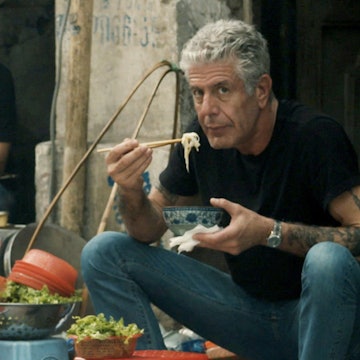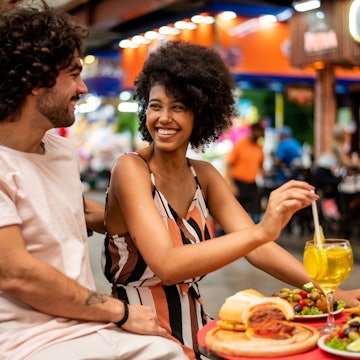

Amazonic traditional fruits on road shop
South America today is a food enthusiast’s dream – its ancient cultures, homegrown ingredients and diverse communities have combined to form a dazzling array of cuisines.
Indigenous culinary traditions developed here over thousands of years, while successive waves of influence from Europe, Africa, the Middle East and Asia brought countless new ingredients to the table. Here we present some of the continent’s unmissable dishes and offer pointers on where to find them.

Unique fruits in the Amazon
The Amazon rainforest’s famous biodiversity applies as much to food as it does to wildlife. Travellers with a sense of culinary adventure will discover rare fruits which, for a variety of reasons, never make it out of the Amazon. The Amazon officially falls within the territories of nine nations, but regardless of which part you happen to be visiting, the best place to find a wide range of items will be the local street market.
Two of the most intriguing fruits are cupuaçú and bacurí. Cupuaçú look like a dinosaur eggs covered in suede; break one open and things get even more interesting. The meaty yellow flesh has a sweet-sour pungency that combines notes of banana, pineapple and nail polish remover. Bacurí are about the size of a large tennis ball. Inside the shell are creamy white sections of pulp with a sweet aroma that will have you swooning. Look for these fruits and more at markets like Brazil’s centuries-old Mercado Ver-o-Peso (in the 17th-century Amazonian port city of Belém) or in Peru’s Belén Mercado in Iquitos, ‘the capital of the Peruvian Amazon.’
Meaty treats in Lima, Peru
Peru’s capital offers, arguably, the best dining scene of any city in South America. Blessed with an abundance of fantastic seafood, tropical fruits and other unique ingredients, Lima is home to some of the world’s top fine dining establishments as well as a host of street stalls and markets. And while the citrus-cured seafood dish of ceviche should be at the top of every visiting gourmand’s list, there are also some fantastic meaty dishes that should not be missed.
Anticuchos are skewers of spiced and marinated beef hearts, grilled over charcoal until tender. Anticuchos Grimanesa in the Miraflores district is a good option for first-timers.
Chancho al Cilindro is a dish of pork belly, smoked low and slow in specialised metal barrels. The end result is some of the most succulent, smoky, melt-in-the-mouth meat you’ll ever have the fortune to encounter. Go straight to Al Cilindro de Javi if you can’t wait any longer.

Afro-Brazilian cuisine in Salvador, Brazil
Salvador, the original capital of Brazil, was once a major hub of the transatlantic slave trade. Today the African influence can still be felt in many aspects of life – the music, religion and the food. Whether waiting at a bus stop or exploring the region’s colonial town squares, the pungent aroma of unrefined red palm oil is never far away. Known locally as dendê, red palm oil is a staple of West African cuisine and a key ingredient in many of the must-try Afro-Brazilian dishes of the region (the dendê used in Brazilian cuisine has been grown locally for centuries and its production is not related to the environmental havoc being caused by the palm oil plantations in Indonesia and Malaysia).
Acarajé is a street-food dish made of mashed black-eyed peas, fried in dendê and stuffed with salted shrimp, a cashew-based sauce called vatapá, salad and chilli sauce. For a great intro to this dish, check out the no-nonsense local spot Acarajé da Cira on Rio Vermelho.
Moqueca is a rich stew of seafood, coconut milk, tomatoes, peppers and dendê. Served with rice, toasted cassava flour and a rich, fishy gravy called pirão, many consider this to be the most delicious of all Brazilian dishes. Grab a hearty helping at Restaurante Paraíso Tropical.

Arepas and bandeja paisa in Bogotá, Colombia
Colombia’s increasingly stable political situation has drawn growing numbers of travellers to discover a startlingly beautiful country populated by some of the friendliest people in South America. Which is good news for foodies – Colombia has some truly unique local treats.
Arepas are corn patties sold on street corners across Colombia and Venezuela. There are countless variations, though some of the best are grilled over charcoal then stuffed with eggs, cheese, shredded chicken and salsa. They’re everywhere in the region – a great place to begin in Bogotá might be El Vecino on Calle 73.
Bandeja paisa is a hearty dish perfect for active travellers looking to fill up without breaking the bank. Served on a tray in order to fit everything in, the dish consists of rice, beans, chorizo sausages, chicharrón (crispy fried pork belly), ground beef, smashed plantains, avocado, arepas and a fried egg. A favourite neighbourhood spot is Casa Vieja.
Pizza in Buenos Aires, Argentina
You could easily spend a whole week in Buenos Aires eating nothing but world-class steaks and empanadas, but porteños (as the locals are known) are at least as passionate about their pizzerias as they are their parrillas (grills). Pizza purists should approach BA pizzas with an open mind – there are several styles unique to the city and woe betide anyone who dares to suggest these are in any way substandard.
Fugazetta is an obscenely cheesy, deep-pan pizza topped with onions, a sprinkle of herbs and a drizzle of olive oil (tomatoes do not feature). Two slices of this cheesy behemoth are generally more than enough. Try the good stuff at La Mezzetta.
Fainá is technically not a pizza, but commonly accompanies the BA slice. This thick, chickpea-based pancake is cut into wedges and often served atop the pizza itself. Confused? See for yourself at Banchero, in the vibrant, tango-fueled neighbourhood of La Boca.
Salteñas in La Paz, Bolivia
Stuffed savoury pastries are popular in many countries of South America. Bolivia’s version of this convenient snack is the salteña. While not a million miles away from Argentinian empanadas, salteñas are notable for being filled with rich, soupy gravy which can make them a gloriously messy affair to the uninitiated. Salteñas are primarily a breakfast snack – most places in La Paz sell out by midday. You can’t do better than Paceña La Salteña for authentic salteñas.

Seafood in Santiago, Chile
The Humboldt Current runs in a northerly direction along the length of Chile’s coastline, bringing with it rich nutrients which support a seafood-lovers dream. Fish markets and restaurants up and down the coast brim with the freshest seafood imaginable. Several varieties of shellfish stand out as extra special.
Picorocos are not for the faint of heart. These giant barnacles are sold alive and have a distinctly alien appearance as they move rather unsettlingly on the fish market stalls like those at Mercado Central. Once cooked in boiling water, they are removed from their casing and eaten whole. Caldillo de congrio, meanwhile, is a rich soup made with eel, tomatoes, white wine and cream. Many swear by its ability to cure a hangover. Try some at the corner hot spot Galindo.
This article was originally published in May 2017 and was updated in May 2019.
https://shop.lonelyplanet.com/products/south-america-on-a-shoestring-travel-guide-13?via=Z2lkOi8vbG9uZWx5LXBsYW5ldC9Xb3JrYXJlYTo6Q2F0YWxvZzo6Q2F0ZWdvcnkvNTllZTQ5YzFmOTJlYTE0MTg2MDU4Nzgw













